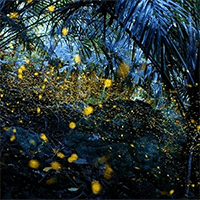- Age 12~Age 99
- 3~4 hours
- 10:00
A painting experience in nature. Mr. Kengo Ukita of Ukita Kiln has a history of attending a design school in Tokyo after training at Tokuda Yasokichi Pottery. The pottery-making environment that he obtained after moving from the Komatsu Airport area is a source of playful inspiration. The natural and tranquil environment around the studio, the view of greenery that jumps out from the window of the work desk, and the occasional music session with friends in the gallery. The pop style of Mr. Ukita's works inspired by them has a familiarity and warmth that is somewhat different from the classic motifs associated with the word "Kutani ware". In the GEMBA program, under the guidance of Mr. Ukita, you can experience overglaze painting from sketching a rough sketch in the backyard. The overglaze painting experience, which starts with a sketch surrounded by greenery, is a unique and valuable experience. *For foreign nationals: Information on the day will be in Japanese only.
- Age 10~Age 80
- 2~3 hours
- 10:00
Painting experience in Ginza, Tokyo / Experience painting "Red Fuji" and "Wave Fuji" from Katsushika Hokusai's famous painting series [36 Views of Mount Fuji] on a plate. Using Kutani paints (Japanese paints) on a Kutani white porcelain plate, you will create a beautiful, authentic Japanese-style masterpiece! *By using original outline transfer paper as a base, even complete beginners can create high-quality works in a short amount of time. After a lecture on how to use and paint with Japanese paints in the first 30 minutes and practicing, you will finish your work in about 2 hours. Why not have fun, but concentrate seriously and paint a masterpiece of Japanese traditional culture?
- Age 16~Age 99
- 1~2 hours
- 10:00 / 14:00
The back side of the colorful color. Among the many "traditions" and "evolutions" of Nishikiyama kiln, there are many fans in the world view and charm of the work, and we pursue "Kinrande" works using gold leaf that we create independently. Kinrande kiln. The second generation owner, Minori Yoshita, is widely known as a living national treasure of Kutani ware. In this program, you can see the inquisitive spirit transmitted to the Nishikiyama kiln and experience a part of it in order to demonstrate the creativity that can be said to be a transcendental technique that looks very profane. Nishikiyama kiln with a history of over 100 years. In addition to traditional techniques, we are also working on new things in the face of the big question, "How will we deliver it in the next 100 years?" We will review traditional techniques, search for a way that is suitable for our current life, and train the staff of the kiln. Nishikiyama kiln manufacturing aims to integrate tradition and innovation. "Kinrande" Kinrande refers to the decorative technique of fixing gold on colored ceramics and its works. Beginning with the Song dynasty in China, it flourished from the Ming dynasty to the Qing dynasty. In Japan, the Kinrande appeared from the Genroku era of Edo, using the Ming dynasty's Jingde Town kiln as an example, and it resembled the "Kinrande" woven fabric woven with gold thread and cut gold leaf, so it came to be called by this name in Japan. rice field. There are techniques such as "drawing gold" to draw a line with gold paint, "swinging gold" to scatter gold powder, and "pasting gold" to paste gold leaf. * For foreign nationals: Information on the day will be in Japanese only.
- Age 13~Age 99
- 1~2 hours
- 10:00 / 14:00
The back side of the colorful color. Among the many "traditions" and "evolutions" of Nishikiyama kiln, there are many fans in the world view and charm of the work, and we pursue "Kinrande" works using gold leaf that we create independently. Kinrande kiln. The second generation owner, Minori Yoshita, is widely known as a living national treasure of Kutani ware. In this program, you can see the inquisitive spirit transmitted to the Nishikiyama kiln and experience a part of it in order to demonstrate the creativity that can be said to be a transcendental technique that looks very profane. Nishikiyama kiln with a history of over 100 years. In addition to traditional techniques, we are also working on new things in the face of the big question, "How will we deliver it in the next 100 years?" We will review traditional techniques, search for a way that is suitable for our current life, and train the staff of the kiln. Nishikiyama kiln manufacturing aims to integrate tradition and innovation. "Kinrande" Kinrande refers to the decorative technique of fixing gold on colored ceramics and its works. Beginning with the Song dynasty in China, it flourished from the Ming dynasty to the Qing dynasty. In Japan, the Kinrande appeared from the Genroku era of Edo, using the Ming dynasty's Jingde Town kiln as an example, and it resembled the "Kinrande" woven fabric woven with gold thread and cut gold leaf, so it came to be called by this name in Japan. rice field. There are techniques such as "drawing gold" to draw a line with gold paint, "swinging gold" to scatter gold powder, and "pasting gold" to paste gold leaf. * For foreign nationals: Information on the day will be in Japanese only.
最近チェックしたプラン
Please wait a moment
![[GEMBA Monozukuri Expo 2023] Backyard sketching and overpainting learned from POP Kutani's pronounsの画像](https://img.activityjapan.com/10/38562/10000003856201_X9MeawNo_3.jpg?version=1664508902)
![[Tokyo, Ginza] Painting experience: Paint the famous Katsushika Kitasuna paintings "Red Fuji" and "Wave Fuji" on a plate! Tools available for rental, empty-handedの画像](https://img.activityjapan.com/10/55825/10000005582501_AVWlGGNt_3.jpg?version=1724293205)
![[GEMBA Monozukuri Expo 2023] Immerse yourself in the world of beautiful glazed gold colors created by living national treasures with a gallery tour and brocade experienceの画像](https://img.activityjapan.com/10/51016/10000005101601_X9MeawNo_3.jpg?version=1695888317)
![[Ishikawa/Komatsu City] KUTANism 2023 Workshop Tour: Immerse yourself in the beautiful world of glazed gold color created by a Living National Treasure, gallery tour and Kinrande experienceの画像](https://img.activityjapan.com/10/50978/10000005097801_X9MeawNo_3.jpg?version=1695703882)







